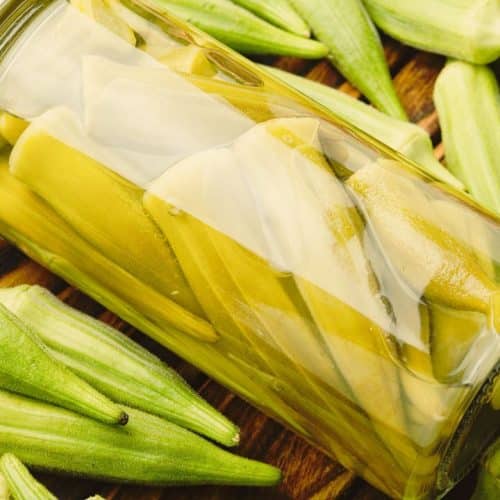How to Can Okra (Canned Okra Recipe)

We’ll take you through the step-by-step process of canning okra, making it easy for beginners and seasoned canners alike. Get ready to savor the goodness of tender and tangy okra in a beautiful jar of homemade Canned Okra Recipe!
As a seasonal vegetable, okra is only available fresh during the warmest months of the year. However, loving okra’s unique flavor, texture, and versatility doesn’t mean you have to say goodbye once summer ends! Preserving okra through water bath canning allows you to enjoy homemade gumbos, stews, and fried okra even in the dead of winter.
I’m always looking for new vegetables to preserve for year-round enjoyment. Okra is one of my favorite summer crops, with its unique texture and versatility in gumbos, stews, and more.
I wanted to learn the ins and outs of canning okra to keep my pantry stocked through the winter. After researching tested recipes and techniques, I successfully canned my 11th batch of okra using the water bath method. Read on for my complete guide to canning okra at home, from start to finish!
Why Should You Can Okra?
Canning okra is a great way to preserve the flavor and texture of fresh okra to enjoy long after the season has ended. Here are some of the benefits of homemade canned okra:
- Enjoy okra on your shelf for up to a year after harvest season
- Adds convenience – no need to run to the store for one ingredient
- Customize with your favorite seasonings like dill, chili flakes, or garlic
- Make gumbos, soups, and stews with canned okra in minutes
- Best flavor and texture – like just-picked fresh okra
- Avoid canned okra from the store packed in preservatives
- Impress family and friends with beautiful home-canned creations
- Saves money compared to store-bought canned vegetables
Step-by-Step Instructions for Canned Okra Recipe
Follow these simple steps for safe, successful batches of canned okra using the water bath method. I use pint-sized mason jars for my okra canning.
Canned Okra Ingredients:
For one pint jar you will need:
- 1 pound fresh okra pods
- 1 tsp salt (optional)
- Water (optional)
- Canning lid and ring
Equipment Need to Canned Okra
- Quart or pint-sized mason jars with new lids/rings
- Water bath canner or large pot with rack
- Jar lifter
- Funnel
- Bubble remover/headspace measuring tool
- Clean kitchen towels
How to Make Canned Okra at Home
Prep the okra jars and lids:
First, inspect your jars for Canned Okra, look for any chips or cracks, and ensure they are sparkling clean. Wash in hot soapy water and rinse well. Place the jars in a large pot of water and bring to a simmer for 10 minutes to sterilize. Turn off the heat and leave jars in the hot water until ready to fill.
Prepare your lids and bands by washing them in hot soapy water and setting them aside until needed. Don’t boil the lids, as that could compromise the seal.
Prep the okra:
Rinse your fresh okra and trim the stem ends. Leave whole or cut into 1 inch pieces. I prefer whole pods for the best texture.
Pack the jars:
Now it’s time to fill the hot sterile jars with the okra. You can use the raw pack or hot pack method.
Raw pack: Pack raw okra tightly into the jars. Place 1 tsp salt in each jar (optional). Leave 1 inch headspace.
Hot pack: Add okra to a saucepan and add 1 cup water per 1 lb of okra. Bring to a boil and cook for 2 minutes. Loosely pack hot okra into the jars using a funnel and add cooking liquid, leaving 1 inch of headspace.
Remove air bubbles:
Slide a bubble remover or thin plastic utensil around the inside of the jar to remove trapped air bubbles. Refill with more okra if needed to maintain headspace.
Seal and process the jars:
Wipe the rims with a clean towel. Place prepped lids and screw bands on firmly but not overly tight.
Process the jars in a water bath canner filled halfway with hot water. Make sure the water covers the jars by at least 1 inch. Bring the water to a rolling boil. Once boiling, process pint jars for 25 minutes.
Cool and test the seal:
Carefully remove the jars from the canner using a jar lifter. Avoid tilting or tipping. Allow to cool undisturbed for 12-24 hours. Test seals by pressing gently on the lids. They should not pop up and down. Refrigerate any jars with broken seals and use them first.
And that’s it – beautiful home-canned okra sealed and ready for your pantry!
Tips for Delicious Canned Okra Results
Follow these tips for flavorful canned okra your family will request all year:
- Choose young, tender pods under 3 inches long
- Leave whole or cut into uniform pieces for appealing consistency
- Minimize sliminess by trimming pods, hot packing, and not overprocessing
- Add a teaspoon of lemon juice or vinegar per jar as an acidifier
- Throw in a garlic clove, peppercorn, or bay leaf for extra flavor
- Use freshly harvested okra – don’t let it sit too long before canning
- Allow sealed jars to cure for 1-2 weeks to evenly distribute flavor
- Refrigerate after opening for best quality and use within 1-2 months
Common Questions
If you’re new to preserving okra, here are answers to some frequently asked questions:
How long will home-canned okra last in storage?
Properly canned okra will maintain quality and safety on the shelf for 12 months. Always inspect jars before opening – discard any with mold, odors, or broken seals.
Can I adjust the processing time for Canning okra?
No, it’s important to follow the verified processing time of 25 minutes for pint jars to prevent spoilage and botulism risk. Only adjust the time based on your altitude.
Is it necessary to use a pressure canner for okra?
No, a regular boiling water bath canner is fine for canning naturally acidic foods like okra. Pressure canning is only required for low-acid vegetables.
What causes okra to be slimy when canning it?
Young, tender okra has less slime. Cutting okra releases its slime-forming juices. Minimize this with gentle handling, hot packing, and avoiding over-processing.
Can I include onions, garlic, or other seasonings when canning okra?
Yes, feel free to add extra flavor! Just maintain the necessary headspace as jar volume decreases
What if my jars failed to seal properly?
Reprocess unsealed jars with new lids within 24 hours or store them in the refrigerator and use canned okra within 2-3 days. Do not consume from unsealed jars.
Can I substitute frozen okra when canning?
It’s best to only can fresh okra, as frozen tends to become soggy during processing. Thaw frozen okra first if you do use it.
Why is my canned okra slimy?
Canned okra gets slimy when the natural mucilage is released. This happens more with larger, more mature pods. Trimming okra, gently handling, hot packing, and avoiding over-processing can minimize slime. An acidifier like lemon juice also helps.
Why is my canned okra cloudy?
Cloudiness in canned okra is usually caused by starch. This is harmless but can be prevented by thoroughly rinsing okra, cutting it into uniform pieces, and hot packing to activate pectins. Processing for the full recommended time will also reduce cloudiness.

Canned Okra Recipe
Equipment
- Pint or quart sized mason jars with new lids & rings
- Water bath canner or large pot with rack
- Jar lifter
- Funnel
- Bubble remover or headspace measuring tool
- Clean kitchen towels
Ingredients
- 1 pound fresh okra pods
- 1 tsp salt optional
- Water optional
- Canning lid and ring
Instructions
- First, inspect your jars for any chips or cracks and ensure they are sparkling clean. Wash in hot soapy water and rinse well. Place the jars in a large pot of water and bring to a simmer for 10 minutes to sterilize. Turn off heat and leave jars in the hot water until ready to fill.
- Prepare your lids and bands by washing in hot soapy water and setting aside until needed. Don’t boil the lids, as that could compromise the seal.
- Rinse your fresh okra and trim the stem ends. Leave whole or cut into 1 inch pieces. I prefer whole pods for the best texture.
- Now it’s time to fill the hot sterile jars with the okra. You can use the raw pack or hot pack method.
- Raw pack: Pack raw okra tightly into the jars. Place 1 tsp salt in each jar (optional). Leave 1 inch headspace.
- Hot pack: Add okra to a saucepan and add 1 cup water per 1 lb of okra. Bring to a boil and cook for 2 minutes. Loosely pack hot okra into the jars using a funnel and add cooking liquid, leaving 1 inch of headspace.
- Slide a bubble remover or thin plastic utensil around the inside of the jar to remove trapped air bubbles. Refill with more okra if needed to maintain headspace.
- Wipe the rims with a clean towel. Place prepped lids and screw bands on firmly but not overly tight.
- Process the jars in a water bath canner filled halfway with hot water. Make sure the water covers the jars by at least 1 inch. Bring the water to a rolling boil. Once boiling, process pint jars for 25 minutes.
- Carefully remove the jars from the canner using a jar lifter. Avoid tilting or tipping. Allow to cool undisturbed for 12-24 hours. Test seals by pressing gently on the lids. They should not pop up and down. Refrigerate any jars with broken seals and use first.
- And that’s it – beautiful home-canned okra sealed and ready for your pantry!
I hope this comprehensive guide gives you the knowledge and confidence to start canning your own okra! Let me know if you have any other okra tips or recipe requests. Happy canning!






